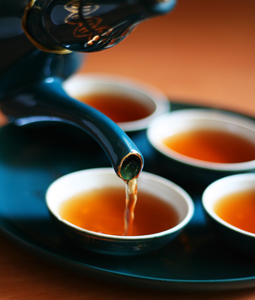The Origins and History of Yaupon Holly

As more and more people search for caffeinated alternatives to coffee, plant based tisanes are gaining traction for their health benefits. They have the ability to soothe and heal as they energize. As a result, tisanes containing caffeine are imported around the world to satisfy enormous demand. Interestingly, Yaupon Holly (Ilex Vomitoria), the only caffeinated plant native to North America, has for many years flown under the radar of the global tea market. Yaupon has a long history of use on this continent, and once boasted a strong global presence among the favored teas of the 1700s. This berry producing member of the Holly family is related to Yerba Matte (Ilex Paraguariensis) and grows as a ground shrub in the Southeastern United States. Though its use as a tisane faded for many years from common knowledge, Yaupon is more recently finding many happy tea drinkers who love it for its caffeine, antioxidants, and its harmonious presence in the local-foods movement.
In the arid South-East of North America, the landscape is populated by the hardiest of plants. Sun-toughened trees and shrubs, that can withstand the droughts and intense heat of the area, are the ones that survive. So it has been within the expanse of our human ecological memory of this area. Yaupon Holly's white berries, though poisonous to humans, are prized by birds, bears, armadillos, and raccoons. White tail deer graze on the tree's waxen leaves. Yaupon Holly is a ubiquitous figure in the Southeastern United States, so much so that gardeners, landscapers, and farmers of the area wage a fairly continuous battle to keep the sturdy and tenacious trees from taking over their land. Locals have been surprised to hear that the tree, so commonplace to the land they live in, is gaining steam as an artisanal drink in high end restaurants who source their ingredients locally.
Long ago, tisanes made from Yaupon Holly were as prevalent as the trees themselves. Many of the indigenous tribes of the area drank the tea regularly, long before European settlers arrived and noted its use. The Seminole tribe of Florida drank Yaupon Holly regularly, and special concentrated brews of the tea were consumed in large quantities during ceremonies. Settlers of the area soon began drinking it themselves and then exporting it to England as "Cassina" and to France as "Appalachia."
The antioxidant properties of Yaupon Holly were a great boon to both the indigenous community, as well as the settlers, who were continuously staving off the importation of diseases from new arrivals. While journeying through the southeast in 1775, naturalist William Bartrum wrote that Cherokees referred to Yaupon as "the beloved tree." Yaupon Holly boasts similar levels of caffeine to Asian Green and Black teas. It's historic reputation among the Seminole tribe as a tonic for health may be owed to its levels of vitamins A and C, as well antioxidant levels comparable to blueberries.
The aforementioned ceremonial usage of Yaupon Holly tea included purging rituals, and while the tea itself was not responsible for the ensuing vomiting, an association was formed. As explorers spent time in the communities using Yaupon Holly for these ceremonies, perhaps its ritual uses were more interesting to write about than it's daily, casual imbibing. We are left with much documentation of warriors drinking the tea and vomiting, but under any remotely close reading of these eyewitness accounts, we easily disconnect the possibility of purging from the casual drinker. Those partaking in the ceremonies endured a three-day long fast, and then drank a strong, viscous brew of Yaupon Holly, which of course, on an empty stomach, induced the subsequent vomiting. Preparing Yaupon tea in its traditional form is something of a lost art. As the popularity of Asian teas surged during the 1700s, Yaupon ceased to be a central player in the tea trade, and today, the way the indigenous community and early tea merchants prepared the leaves of the tree remains unknown. Those who work with Yaupon today must create their own methodology. Today, Yaupon Holly is prepared similarly to green tea or as roasted black tea, and many find the flavor profile of Yaupon pleasingly similar to a black tea, though slightly less bitter. Dai Due and Odd Duck, two sustainable and locally sourced restaurants in Austin, Texas, are finding that their customers are very fond of the tea. Their patrons love satiating their caffeine needs with a brew of leaves from a tree that they encounter daily in the world around them. There is something pleasing and intimate about the immediacy of that interaction with the landscape, that drinks imported from far away lands cannot provide. Whether those Austinites know it, their consumption of Yaupon Holly makes them part of a tea-drinking lineage dating back over a thousand years.
